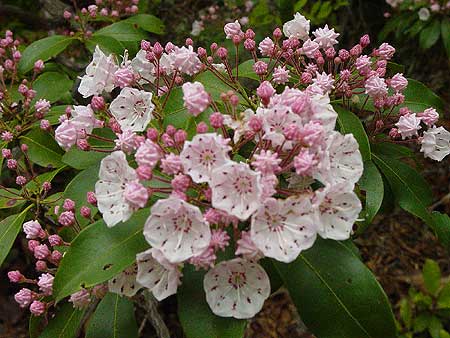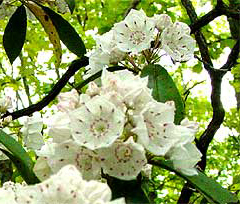 Mountain Laurel
Mountain Laurel
Kalmia latifolia
From USDA
General Description.―Mountain laurel, known
also as calico-bush, ivy, ivybush, kalmia, laurel,
and spoonwood, is a medium to large (2 to 9 m in
height) evergreen shrub, often with contorted stem
and branching habit. The thick, flat, leathery
leaves are shiny, dark-green above and pale-green
below; margins are entire. Leaf length ranges from
5 to 12 cm and width from 1.5 to 5 cm. The
yellowish green petioles range from 0.7 to 3 cm
long. The thin, reddish-brown bark shreds and
subdivides into ridges. In the absence of
disturbance (usually fire), the species is long-lived:
40 to 60 years. Botanical
characteristics of the genus Kalmia have been
studied intensively. Kalmia is the
state flower of Connecticut and Pennsylvania.
The method
of pollen dispersal in Kalmia is unusual in that the
anthers are under tension as the flower matures,
and they spring forward when disturbed by an
insect, forcefully and effectively transferring
grains of pollen to the insect (Jaynes 1997). The
flowers are pollinated by more than a dozen
insects, primarily bumblebees, but generally not
honeybees, likely because the flowers produce
little nectar (Jaynes 1997).
HOME "M"LIST

 Mountain Laurel
Mountain Laurel